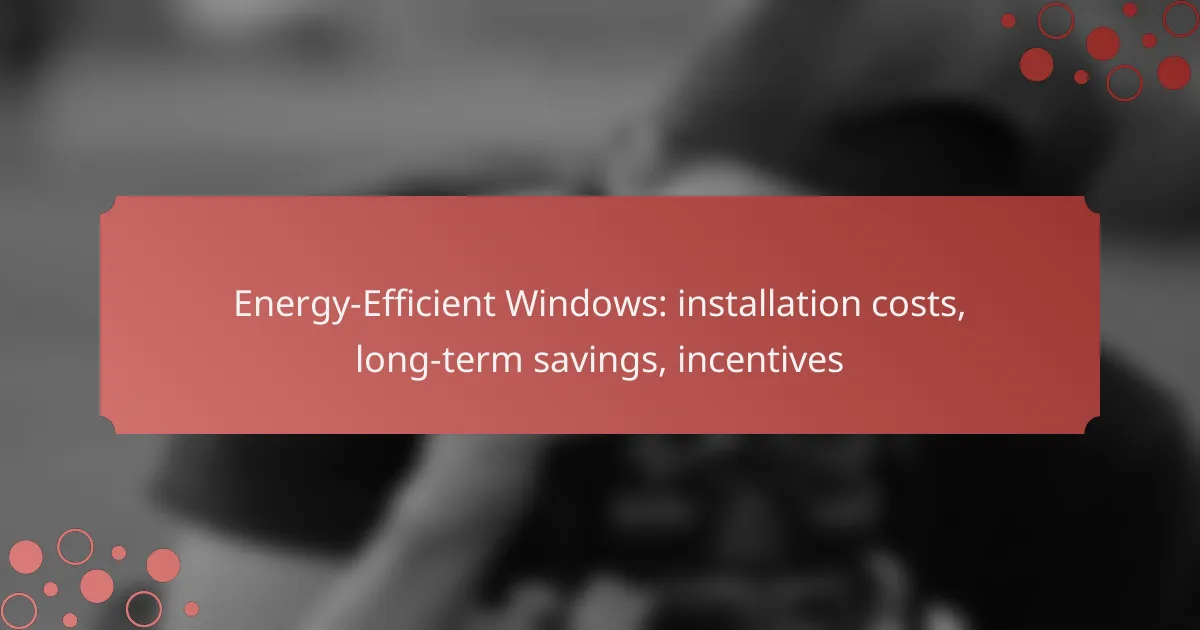Energy-efficient windows are a valuable investment for homeowners, with installation costs in the UK typically ranging from £300 to £1,000 per window. These windows not only reduce energy consumption for heating and cooling, leading to lower utility bills, but also come with various incentives that can help offset initial expenses. By minimizing heat transfer and maintaining a consistent indoor temperature, energy-efficient windows contribute to significant long-term savings.
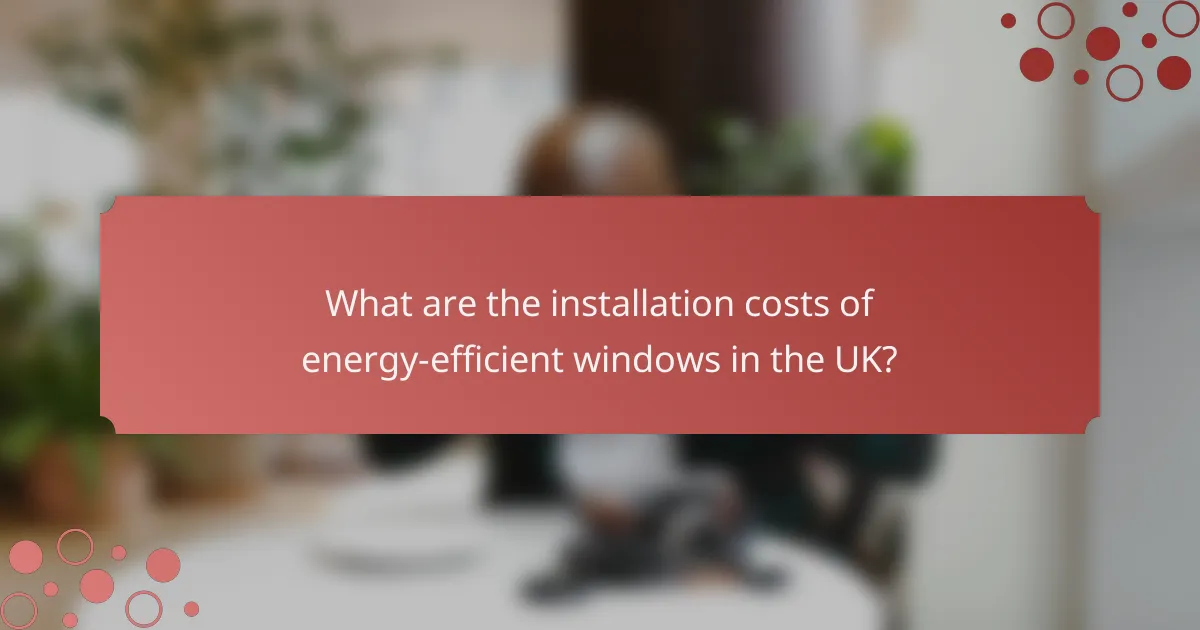
What are the installation costs of energy-efficient windows in the UK?
The installation costs of energy-efficient windows in the UK typically range from £300 to £1,000 per window, depending on various factors such as the type of window and installation complexity. Investing in these windows can lead to significant long-term savings on energy bills.
Average cost per window
The average cost of energy-efficient windows in the UK generally falls between £400 and £800 per unit. This price range includes both the window itself and the installation fees. Higher-end models, such as triple-glazed windows, may cost more, often exceeding £1,000 each.
Factors affecting installation costs
Location within the UK can also affect pricing. For example, installation costs may be higher in London compared to rural areas due to increased labor and material expenses. Always obtain multiple quotes to ensure you get a fair price.
Cost comparison with traditional windows
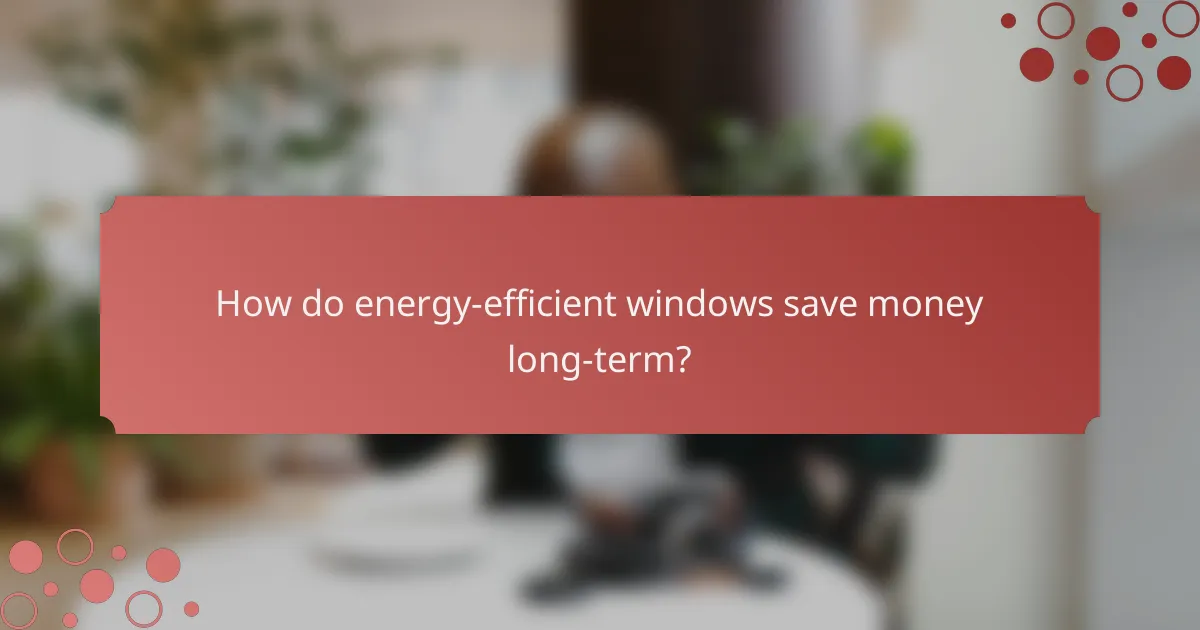
How do energy-efficient windows save money long-term?
Energy-efficient windows save money long-term by reducing energy consumption for heating and cooling, leading to lower utility bills. Their advanced technology minimizes heat transfer, which helps maintain a consistent indoor temperature and reduces reliance on HVAC systems.
Energy savings over time
Investing in energy-efficient windows can yield significant savings over the years. Homeowners may see reductions in energy costs ranging from 10% to 30%, depending on the climate and existing window conditions. Over a lifespan of 20 years, these savings can accumulate to thousands of dollars.
Additionally, energy-efficient windows often qualify for energy efficiency ratings, such as ENERGY STAR, which can further enhance their value and appeal. This certification indicates that the windows meet specific energy-saving criteria, making them a smart choice for long-term savings.
Impact on heating and cooling bills
Energy-efficient windows can dramatically lower heating and cooling bills, especially in regions with extreme temperatures. By minimizing heat loss in winter and reducing heat gain in summer, these windows help maintain a comfortable indoor environment without excessive energy use.
For example, a household in a colder climate might save around $100 to $300 annually on heating costs alone. In warmer areas, savings on cooling bills can be similarly substantial, making these windows a worthwhile investment for many homeowners.
Return on investment analysis
The return on investment (ROI) for energy-efficient windows can be compelling. Homeowners typically recoup 70% to 80% of their initial investment when selling their homes, thanks to increased property value and appeal to energy-conscious buyers. This makes energy-efficient windows not just a cost-saving measure but also a smart financial decision.
To maximize ROI, consider local incentives or rebates for energy-efficient upgrades. Many states and municipalities offer financial assistance that can offset installation costs, making the initial investment more manageable and enhancing overall savings.
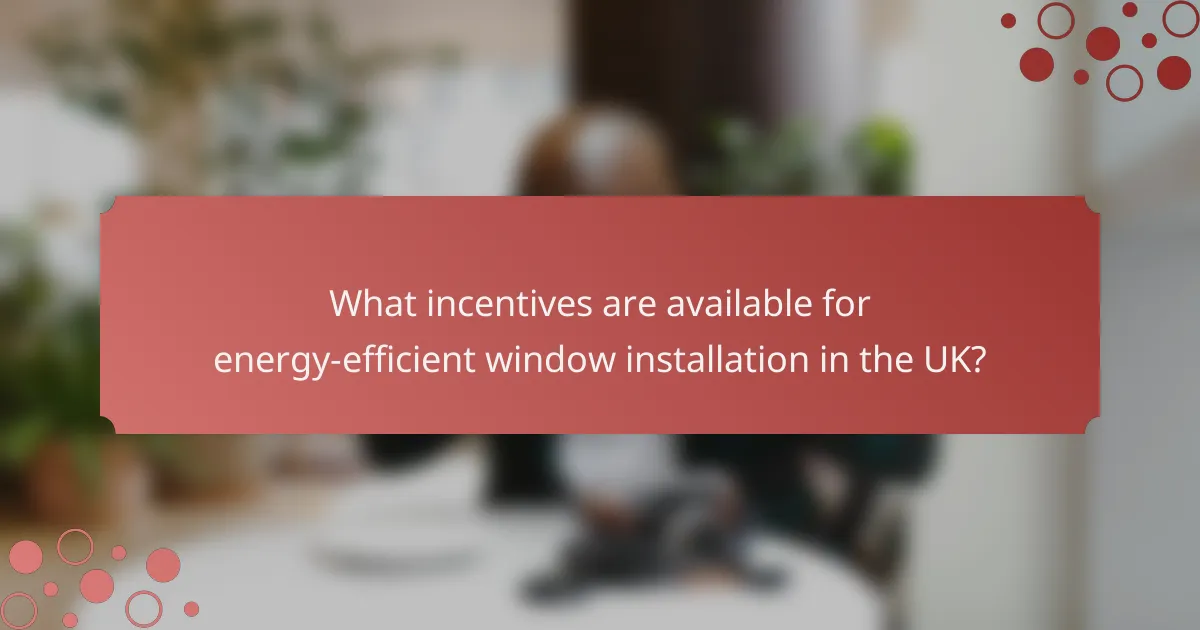
What incentives are available for energy-efficient window installation in the UK?
In the UK, various incentives are available to encourage homeowners to install energy-efficient windows. These incentives can significantly reduce upfront costs and enhance long-term savings on energy bills.
Government grants and rebates
The UK government offers several grants and rebates for energy-efficient home improvements, including window installations. Programs like the Energy Company Obligation (ECO) provide funding for low-income households to improve their energy efficiency. Homeowners can receive financial support that covers a portion of the installation costs, making it more accessible.
To apply for these grants, homeowners typically need to demonstrate eligibility based on income or property type. It’s advisable to check the official government website for the latest information and application procedures.
Local authority schemes
Many local authorities in the UK have their own schemes to promote energy efficiency, which may include financial assistance for window installations. These schemes can vary significantly by region, so it’s essential to consult your local council for specific offerings.
Some councils may provide direct funding, while others might offer low-interest loans or partnerships with local contractors for discounted installations. Engaging with local authorities can uncover additional savings opportunities.
Tax credits for homeowners
Homeowners in the UK may also benefit from tax credits related to energy-efficient upgrades, including window installations. While specific tax credits can change, they often allow for deductions on the cost of energy-saving improvements.
It’s important to keep receipts and documentation of the installation to claim these credits. Consulting with a tax professional can help ensure you take full advantage of available benefits while complying with regulations.
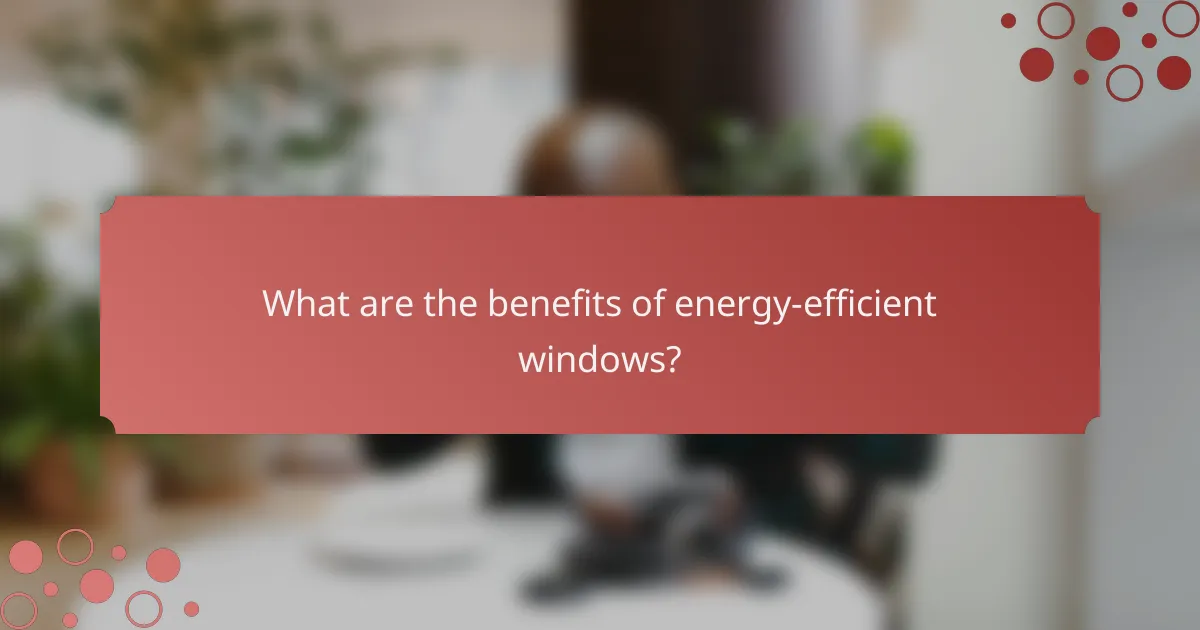
What are the benefits of energy-efficient windows?
Energy-efficient windows provide significant advantages, including lower energy bills, enhanced comfort, and increased property value. By minimizing heat loss and gain, these windows help maintain a stable indoor temperature, leading to long-term savings and environmental benefits.
Improved insulation properties
Energy-efficient windows are designed with advanced insulation features that significantly reduce heat transfer. This includes double or triple glazing, low-emissivity (Low-E) coatings, and gas fills like argon or krypton. These elements work together to keep homes warmer in winter and cooler in summer, enhancing overall comfort.
When considering installation, look for windows with a high R-value, which indicates better insulation performance. In many regions, energy-efficient windows can reduce heating and cooling costs by 10-25% annually, depending on climate and usage patterns.
Increased property value
Installing energy-efficient windows can boost your property’s market value. Homebuyers are often willing to pay more for homes with lower energy costs and improved comfort. In some cases, the return on investment can be significant, with estimates suggesting that homeowners may recoup 70-80% of their window replacement costs upon sale.
Additionally, energy-efficient windows can make your property more attractive in competitive real estate markets. Highlighting these features during a sale can set your home apart and appeal to environmentally conscious buyers.
Environmental impact reduction
Energy-efficient windows contribute to a reduction in overall energy consumption, which helps lower greenhouse gas emissions. By using less energy for heating and cooling, these windows play a crucial role in combating climate change and promoting sustainability.
Moreover, many regions offer incentives for homeowners who choose energy-efficient upgrades, such as tax credits or rebates. These programs not only help offset installation costs but also encourage environmentally friendly practices, making it easier for homeowners to contribute to a healthier planet.
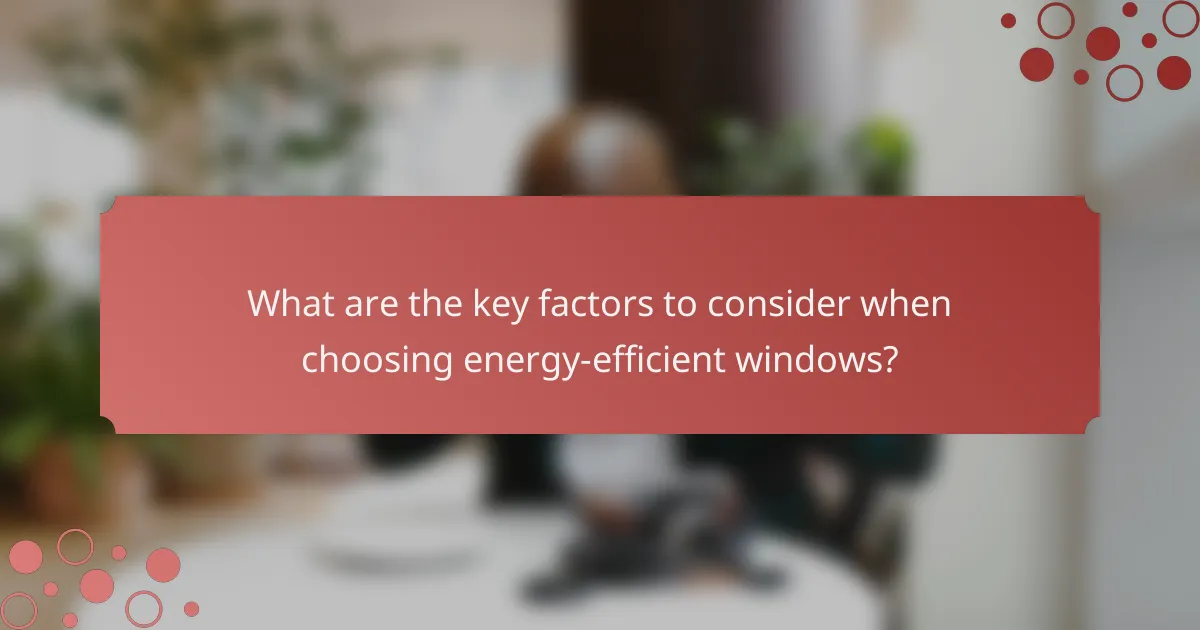
What are the key factors to consider when choosing energy-efficient windows?
When selecting energy-efficient windows, consider factors such as frame materials, glazing options, and local climate. These elements significantly impact energy savings, installation costs, and overall performance.
Window frame materials
Window frame materials play a crucial role in energy efficiency. Common options include vinyl, wood, fiberglass, and aluminum, each with distinct thermal properties and costs. For instance, vinyl frames are generally affordable and offer good insulation, while wood frames provide excellent thermal performance but may require more maintenance.
When choosing materials, consider your local climate. In colder regions, frames with better insulation properties, like fiberglass, may be more beneficial, while in warmer climates, materials that resist heat gain, such as vinyl, can enhance energy efficiency.
Glazing options
Glazing options refer to the type of glass used in windows, which affects energy efficiency. Double or triple glazing is common, with multiple panes providing better insulation than single-pane windows. Low-emissivity (Low-E) coatings can further enhance performance by reflecting heat while allowing light to enter.
When selecting glazing, consider the U-factor and Solar Heat Gain Coefficient (SHGC). A lower U-factor indicates better insulation, while a lower SHGC is preferable in hot climates to reduce cooling costs. Balancing these factors based on your local weather conditions will maximize energy savings.
